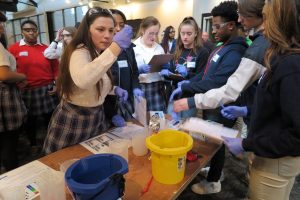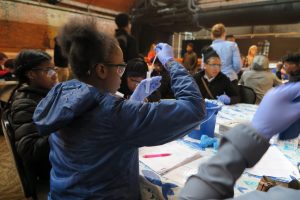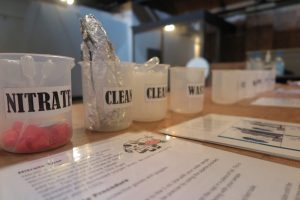Shark Spotlight: Nurse Sharks
It’s that time of year again! Fin Fest is only a few weeks away, and we can’t wait to welcome shark lovers of all ages to the Aquarium to celebrate with us. Sharks are already on our minds 24/7, but Fin Fest gives us an excuse to really show how much we appreciate these jaw-some animals.
This week we’re covering the nurse shark, the sedentary bottom-dweller that can be found hanging around the lower, more secluded areas of the shark gallery. There are a few theories on how nurse sharks got their unusual common name. Most agree that it comes from the old English word “hurse,” meaning “seafloor shark,” but others argue the name was inspired by the sound they make while hunting which is often compared to a nursing baby.
The unique noise comes from their feeding technique, which involves sucking their prey up from the seafloor like a vacuum. Their mouths are just big enough to eat things that live near the bottom, like snails, crustaceans and mollusks, but too small to hunt for larger fish like their fellow sharks do. Being nocturnal hunters, they’ll begin to prowl the seafloor for food at night using the the whisker-like barbels that extend from their face to feel around for things to eat. “Here in Ohio, we think ‘Oh, that looks like a catfish,’” says aquarist Ray Popik of the nurse shark’s appearance, “and they actually do fill a bit of the same ecological niche.”
According to Popik, all of these characteristics go hand-in-hand. “During the daytime you’ll see them underneath ledges and in crevices hiding out. Then at night they’ll cruise the bottom scavenging for food,” he says. “Typically the more bottom-oriented the shark is, the more nocturnal it is. The opposite is true for sharks that are more active hunters, and nurse sharks are usually scavengers in the wild.”
Contrary to the popular belief that all sharks have to remain constantly swimming in order to breathe, nurse sharks and their seafloor-inhabiting peers can push water over their gills themselves without having to move much. They can circulate water through their systems by opening and closing their mouths, which allows them to stay put. The nurse shark’s bottom-dwelling habits usually catch the eye of Aquarium guests, as their behavior differs from the constant cruising of their “gallery mates” the sandtiger and sandbar sharks. However, Popik says their behavior is relatively common for seafloor shark species. “[Their behavior] is unique out of our three species,” he explains, “but it’s not terribly unique in the wild.”
Hanging out in the lower regions of their exhibit, the calm-and-collected nurse shark shows us how varied shark behavior can be in nature. Next week we’ll be talking about the sandbar shark, whose agile swimming and striking silhouette make it one of the most fun to watch animals here at the Aquarium — and don’t forget, Fin Fest is happening right here every day from July 22nd through the 29th. If you love sharks as much as we do, it’s the place to be, so don’t miss out.












